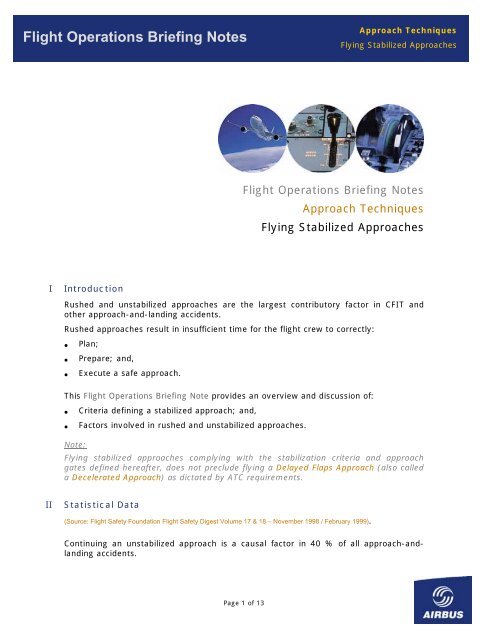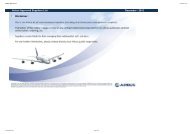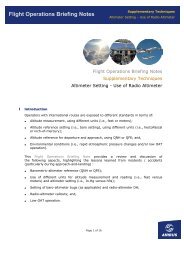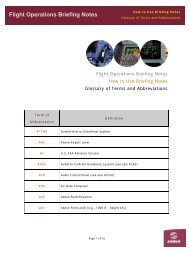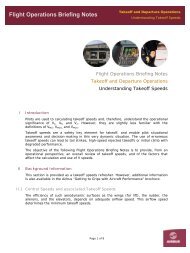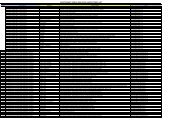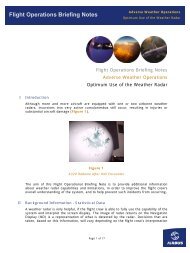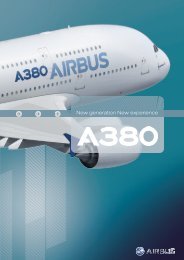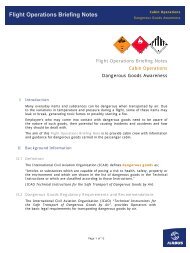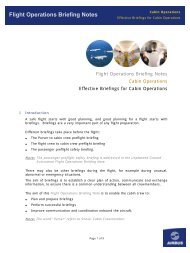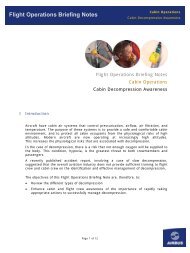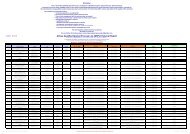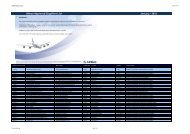Flying Stabilized Approaches - Airbus
Flying Stabilized Approaches - Airbus
Flying Stabilized Approaches - Airbus
Create successful ePaper yourself
Turn your PDF publications into a flip-book with our unique Google optimized e-Paper software.
Flight Operations Briefing Notes<br />
I Introduction<br />
Approach Techniques<br />
<strong>Flying</strong> <strong>Stabilized</strong> <strong>Approaches</strong><br />
Flight Operations Briefing Notes<br />
Approach Techniques<br />
<strong>Flying</strong> <strong>Stabilized</strong> <strong>Approaches</strong><br />
Rushed and unstabilized approaches are the largest contributory factor in CFIT and<br />
other approach-and-landing accidents.<br />
Rushed approaches result in insufficient time for the flight crew to correctly:<br />
• Plan;<br />
• Prepare; and,<br />
• Execute a safe approach.<br />
This Flight Operations Briefing Note provides an overview and discussion of:<br />
• Criteria defining a stabilized approach; and,<br />
• Factors involved in rushed and unstabilized approaches.<br />
Note:<br />
<strong>Flying</strong> stabilized approaches complying with the stabilization criteria and approach<br />
gates defined hereafter, does not preclude flying a Delayed Flaps Approach (also called<br />
a Decelerated Approach) as dictated by ATC requirements.<br />
II Statistical Data<br />
(Source: Flight Safety Foundation Flight Safety Digest Volume 17 & 18 – November 1998 / February 1999).<br />
Continuing an unstabilized approach is a causal factor in 40 % of all approach-andlanding<br />
accidents.<br />
Page 1 of 13
Flight Operations Briefing Notes<br />
Approach Techniques<br />
<strong>Flying</strong> <strong>Stabilized</strong> <strong>Approaches</strong><br />
In 75% of the off-runway touchdown, tail strike or runway excursion/overrun accidents,<br />
the major cause was an unstable approach.<br />
Table 1 shows the factors involved in rushed and unstabilized approaches.<br />
High and/or fast approach<br />
or<br />
Low and/or slow approach<br />
Flight-handling difficulties :<br />
Factor % of Events<br />
- Demanding ATC clearances<br />
- Adverse wind conditions<br />
III Stabilization Heights<br />
Table 1<br />
Factors Involved in Unstabilized <strong>Approaches</strong><br />
66 %<br />
45 %<br />
The following minimum stabilization heights are recommended to achieve timely<br />
stabilized approaches:<br />
Note:<br />
Meteorological Conditions Height above Airfield Elevation<br />
IMC 1000 ft<br />
VMC 500 ft<br />
Table 2<br />
Minimum Stabilization Heights<br />
A lower minimum stabilization height may be allowed for circling approaches<br />
(e.g. 400 ft).<br />
Page 2 of 13
Flight Operations Briefing Notes<br />
IV Defining the Elements of a <strong>Stabilized</strong> Approach<br />
Approach Techniques<br />
<strong>Flying</strong> <strong>Stabilized</strong> <strong>Approaches</strong><br />
An approach is considered stabilized only if all the following elements are achieved<br />
before or when reaching the applicable stabilization height:<br />
Note 1:<br />
The aircraft is on the correct lateral and vertical flight path<br />
(based on navaids guidance or visual references)<br />
Only small changes in heading and pitch are required to maintain this flight path<br />
The aircraft is in the desired landing configuration<br />
The thrust is stabilized, usually above idle, to maintain the target approach speed along<br />
the desired final approach path<br />
The landing checklist has been accomplished as well as any required specific briefing<br />
No flight parameter exceeds the criteria defined in Table 4<br />
Table 3<br />
The Elements of a <strong>Stabilized</strong> Approach – All <strong>Approaches</strong><br />
For Non-Precision <strong>Approaches</strong>, some of these elements (desired landing configuration<br />
and VAPP) should be achieved when the aircraft reaches the FAF (<strong>Airbus</strong> recommended<br />
technique).<br />
Note 2:<br />
Non-normal conditions requiring deviation from the above elements of a stabilized<br />
approach should be briefed formally.<br />
Page 3 of 13
Flight Operations Briefing Notes<br />
V Excessive Flight Parameter Deviation Callouts Criteria<br />
Approach Techniques<br />
<strong>Flying</strong> <strong>Stabilized</strong> <strong>Approaches</strong><br />
When reaching the applicable stabilization height and below, a callout should be<br />
performed by the PNF if any flight parameter exceeds the limits provided in Table 4.<br />
Parameter Callout Criteria<br />
Airspeed Lower than V APP – 5 kt or Greater than V APP + 10 kt (*)<br />
Vertical Speed Greater than – 1000 ft/mn<br />
Pitch Attitude Lower than (**) Nose Down or Greater than (**) Nose Up<br />
Bank Angle Greater than 7 degrees<br />
LOC deviation 1/4 dot or Excessive (Beam) Deviation Warning<br />
Glide Slope deviation<br />
(ILS)<br />
1 dot or Excessive (Beam) Deviation Warning<br />
Table 4<br />
Excessive Flight-Parameter-Deviation Callouts<br />
(*)<br />
The final approach speed V APP is considered to be equal to V REF + 5 kt (or V LS + 5 kt,<br />
as applicable).<br />
V REF is the reference target threshold speed in the full flaps landing configuration<br />
(i.e., in the absence of airspeed corrections because of wind, windshear or non-normal<br />
configuration).<br />
(**)<br />
Refer to the applicable SOPs for applicable pitch attitude limits.<br />
Page 4 of 13
Flight Operations Briefing Notes<br />
VI Benefits of a <strong>Stabilized</strong> Approach<br />
Approach Techniques<br />
<strong>Flying</strong> <strong>Stabilized</strong> <strong>Approaches</strong><br />
Conducting a stabilized approach increases the flight crew’ overall situational<br />
awareness:<br />
• Horizontal situational awareness :<br />
− By closely monitoring the flight path;<br />
• Speed awareness :<br />
− By monitoring speed deviations;<br />
• Vertical situational awareness :<br />
− By monitoring the vertical flight path and the rate of descent;<br />
• Energy awareness :<br />
− By maintaining the engines thrust to the level required to fly a 3-degree<br />
approach path at the final approach speed (or at the minimum ground speed, as<br />
applicable).<br />
This also enhances the readiness for go-around.<br />
In addition, a stabilized approach provides the following benefits:<br />
• More time and attention are available for the monitoring of ATC communications,<br />
weather conditions, systems operation;<br />
• More time is available for effective monitoring and back-up by the PNF;<br />
• Defined flight-parameter-deviation criteria and minimum stabilization height support<br />
the decision to land or go-around;<br />
• Landing performance is consistent with published performance; and,<br />
• Situational awareness is increased.<br />
VII Best Practices<br />
Throughout the entire flight a next target should be defined to stay ahead of<br />
the aircraft at all times.<br />
The defined next target should be any required combination of:<br />
• A position;<br />
• An altitude;<br />
• A configuration;<br />
• A speed;<br />
• A vertical profile (vertical speed or flight path angle); and,<br />
Page 5 of 13
Flight Operations Briefing Notes<br />
Approach Techniques<br />
<strong>Flying</strong> <strong>Stabilized</strong> <strong>Approaches</strong><br />
• A power setting (e.g. thrust is stabilized, usually above idle, to maintain the target<br />
approach speed along the desired final approach path).<br />
If it is anticipated that one or more element(s) of the next target will not be met,<br />
the required corrective action(s) should be taken without delay.<br />
During the approach and landing, the successive next targets should constitute gates<br />
that should be met for the approach to be continued (Figure 1).<br />
Figure 1<br />
Typical Gates during Final Approach<br />
1000 FT<br />
500 FT<br />
The Final Approach Fix (FAF), the Outer Marker (OM) or an equivalent fix<br />
(as applicable) constitute an assessment gate to confirm the readiness to proceed<br />
further; this assessment should include the following:<br />
• Visibility or RVR (and ceiling, as appropriate):<br />
− Better than or equal to applicable minimums;<br />
FAF<br />
• Aircraft readiness:<br />
− Position, altitude, configuration and energy; and,<br />
• Crew readiness:<br />
− Briefing completed and agreement on approach conditions.<br />
Page 6 of 13
Flight Operations Briefing Notes<br />
Approach Techniques<br />
<strong>Flying</strong> <strong>Stabilized</strong> <strong>Approaches</strong><br />
The minimum stabilization height constitutes a particular gate along the final approach<br />
(e.g. for an ILS approach, the objective is to be stabilized on the final descent path<br />
at VAPP in the landing configuration, at 1000 feet above airfield elevation in IMC, or<br />
at 500 feet above airfield elevation in VMC, after continuous deceleration on the glide<br />
slope).<br />
If the aircraft is not stabilized on the approach path in landing configuration,<br />
at the minimum stabilization height, a go-around must be initiated unless the crew<br />
estimates that only small corrections are necessary to rectify minor deviations from<br />
stabilized conditions due, amongst others, to external perturbations.<br />
Following a PNF flight parameter exceedance callout, the suitable PF response will be:<br />
• Acknowledge the PNF callout, for proper crew coordination purposes<br />
• Take immediate corrective action to control the exceeded parameter back into<br />
the defined stabilized conditions<br />
• Assess whether stabilized conditions will be recovered early enough prior to landing,<br />
otherwise initiate a go-around.<br />
VIII Factors Involved in Unstabilized <strong>Approaches</strong><br />
The following circumstances, factors and errors are often cited when discussing rushed<br />
and unstabilized approaches:<br />
• Fatigue (e.g., due to disrupted sleep cycle, personal stress, …);<br />
• Pressure of flight schedule (i.e., making up for takeoff delay, last leg of the day, …);<br />
• Any crew-induced or controller-induced circumstances resulting in insufficient time<br />
to plan, prepare and execute a safe approach;<br />
This includes accepting requests from ATC for flying higher and/or faster than<br />
desired or flying shorter routings than desired;<br />
• ATC instructions that result in flying too high and/or too fast during the initial or<br />
final approach (e.g., request for maintaining high speed down to the [outer] marker<br />
or for GS capture from above – slam-dunk approach);<br />
• Excessive altitude and / or excessive airspeed (i.e., inadequate energy<br />
management) early in the approach;<br />
• Late runway change (i.e., lack of ATC awareness of the time required to reconfigure<br />
the aircraft systems for a new approach);<br />
• Non-standard task-sharing resulting in excessive head-down work (e.g., FMS<br />
reprogramming);<br />
• Short outbound leg or short down-wind leg (e.g., in case of unidentified traffic<br />
in the area);<br />
• Inadequate use of automation: Late takeover from automation (e.g., in case of AP<br />
failing to capture the GS, usually due to crew failure to arm the approach mode);<br />
Page 7 of 13
Flight Operations Briefing Notes<br />
• Premature or late descent due to absence of positive FAF identification;<br />
• Insufficient awareness of wind conditions:<br />
− Tailwind component;<br />
− Low altitude wind shear;<br />
Approach Techniques<br />
<strong>Flying</strong> <strong>Stabilized</strong> <strong>Approaches</strong><br />
− Local wind gradient and turbulence (e.g., caused by terrain, forest or buildings);<br />
or,<br />
− Recent weather along the final approach path (e.g., downdraft caused by<br />
a descending cold air mass following a rain shower);<br />
• Incorrect anticipation of aircraft deceleration characteristics in level flight or on<br />
a 3-degree glideslope;<br />
• Failure to recognize deviations or to remember the excessive-parameter-deviation<br />
criteria;<br />
• Belief that the aircraft will be stabilized at the stabilization height or shortly<br />
thereafter;<br />
• Excessive confidence by the PNF that the PF will achieve a timely stabilization;<br />
• PF/PNF over reliance on each other to call excessive deviations or to call for<br />
a go-around;<br />
• Visual illusions during the visual segment;<br />
• Continued approach without acquisition of adequate visual references or after loss<br />
of visual references;<br />
• Failure to accurately follow the PAPI / VASI; and / or,<br />
• Failure to adequately maintain the aiming point (i.e., duck-under).<br />
IX Typical Deviations Observed in Unstabilized <strong>Approaches</strong><br />
The following procedure deviations or flight path excursions often are observed, alone<br />
or in combination, in rushed and unstabilized approaches (figures provided between<br />
brackets reflect extreme deviations observed in actual unstabilized approaches,<br />
worldwide):<br />
• Full approach flown at idle down to touchdown, because of excessive airspeed<br />
and/or altitude early in the approach;<br />
• Steep approach (i.e., above desired flight path with excessive vertical speed up to<br />
– 2200 ft/mn, flight path angle up to 15 % gradient / 9-degree slope);<br />
Steep approaches appear to be twice as frequent as shallow approaches;<br />
• Shallow approach (i.e., below desired glide path);<br />
• Low airspeed maneuvering (i.e., inadequate energy management);<br />
Page 8 of 13
Flight Operations Briefing Notes<br />
Approach Techniques<br />
<strong>Flying</strong> <strong>Stabilized</strong> <strong>Approaches</strong><br />
• Excessive bank angle when capturing the final approach course (up to 40-degree);<br />
• Activation of a GPWS warning:<br />
− Mode 1 : SINK RATE;<br />
− Mode 2A : TERRAIN (not full flaps);<br />
− Mode 2B : TERRAIN (full flaps).<br />
• Late extension of flaps or flaps load relief system activation (as applicable),<br />
resulting in the late effective extension of flaps;<br />
• Flight-parameter excessive deviation when crossing the stabilization height:<br />
− Excessive airspeed (up to V REF + 70 kt);<br />
− Not aligned (up to 20-degree heading difference);<br />
− Excessive bank angle (up to 40 -degrees);<br />
− Excessive vertical speed (up to – 2000 ft/mn);<br />
− Excessive glide slope deviation (up to 2 dots);<br />
• Excessive bank angle, excessive sink rate or excessive maneuvering while<br />
performing a side-step;<br />
• Speedbrakes being still extended when in short final (i.e., below 1000 ft above<br />
airfield elevation);<br />
• Excessive flight-parameter deviation(s) down to runway threshold;<br />
• High runway-threshold crossing (up to 220 ft);<br />
• Long flare and extended touchdown.<br />
X Company’s Prevention Strategies and Personal Lines-of-defense<br />
Company’s prevention strategies and personal lines-of-defense to reduce the number of<br />
unstabilized approaches should:<br />
• Identify and minimize the factors involved; and,<br />
• Provide recommendations for the early detection and correction of unstabilized<br />
approaches.<br />
The following four-step strategy is proposed:<br />
• Anticipate;<br />
• Detect;<br />
• Correct; and,<br />
• Decide.<br />
Page 9 of 13
Flight Operations Briefing Notes<br />
X.1 Anticipate<br />
Approach Techniques<br />
<strong>Flying</strong> <strong>Stabilized</strong> <strong>Approaches</strong><br />
Some factors likely to result in a rushed and unstabilized approach can be anticipated.<br />
Whenever practical, flight crews and controllers should avoid situations that may result<br />
in rushed approaches.<br />
The descent-and-approach briefing provides an opportunity to identify and discuss<br />
factors such as :<br />
• Non-standard altitude or speed restrictions requiring a careful energy management:<br />
− An agreed strategy should be defined for the management of the descent,<br />
deceleration and stabilization (i.e., following the concepts of next targets and<br />
approach gate);<br />
X.2 Detect<br />
− This strategy will constitute a common objective and reference for the PF and<br />
PNF.<br />
Defined excessive-parameter-deviation criteria and a defined stabilization height<br />
provide the PF and PNF with a common reference for effective:<br />
• Monitoring (i.e., early detection of deviations); and,<br />
• Back-up (i.e., timely and precise deviation callouts for effective corrections).<br />
To provide the time availability and attention required for an effective monitoring and<br />
back-up, the following should be avoided:<br />
• Late briefings;<br />
• Unnecessary radio calls (e.g., company calls);<br />
• Unnecessary actions (e.g., use of ACARS); and,<br />
• Non-pertinent intra-cockpit conversations (i.e., breaking the sterile-cockpit rule).<br />
Reducing the workload and cockpit distractions and/or interruptions also provides<br />
the flight crew with more alertness and availability to:<br />
• Cope with fatigue;<br />
• Comply with an unanticipated ATC request (e.g., runway change or visual<br />
approach);<br />
• Adapt to changing weather conditions or approach hazards; and,<br />
• Manage a system malfunction (e.g., flaps jamming or gear failing to extend or to<br />
downlock).<br />
Page 10 of 13
Flight Operations Briefing Notes<br />
X.3 Correct<br />
Approach Techniques<br />
<strong>Flying</strong> <strong>Stabilized</strong> <strong>Approaches</strong><br />
Positive corrective actions should be taken before deviations develop into a challenging<br />
or a hazardous situation in which the only safe action is a go-around.<br />
Corrective actions may include:<br />
• The timely use of speed brakes or the early extension of landing gear to correct<br />
an excessive altitude or an excessive airspeed;<br />
• Extending the outbound leg or downwind leg.<br />
X.4 Decide<br />
If the aircraft is not stabilized on the approach path in landing configuration,<br />
at the minimum stabilization height, a go-around must be initiated unless the crew<br />
estimates that only small corrections are necessary to rectify minor deviations from<br />
stabilized conditions due, amongst others, to external perturbations.<br />
Following a PNF flight parameter exceedance callout, the suitable PF response will be:<br />
• Acknowledge the PNF callout, for proper crew coordination purposes<br />
• Take immediate corrective action to control the exceeded parameter back into the<br />
defined stabilized conditions<br />
• Assess whether stabilized conditions will be recovered early enough prior to landing,<br />
otherwise initiate a go-around.<br />
The following behaviors often are involved in the continuation of an unstabilized<br />
approach:<br />
• Confidence in a quick recovery (i.e., postponing the go-around decision when<br />
parameters are converging toward target values);<br />
• Overconfidence because of a long and dry runway and/or a low gross-weight,<br />
although airspeed and/or vertical speed are excessive;<br />
• Inadequate readiness or lack of commitment to conduct a go-around;<br />
A change of mindset should take place from:<br />
− “We will land unless …”; to,<br />
− “Let’s be prepared for a go-around and we will land if the approach is stabilized<br />
and if we have sufficient visual references to make a safe approach and<br />
landing”.<br />
• Go-around envisaged but not initiated because the approach was considered being<br />
compatible with a safe landing; and,<br />
• Absence of decision due to fatigue or workload (i.e., failure to remember<br />
the applicable excessive deviation criteria).<br />
Page 11 of 13
Flight Operations Briefing Notes<br />
XI Summary of Key Points<br />
Three essential parameters need to be stabilized for a safe approach:<br />
• Aircraft track;<br />
• Flight path angle; and,<br />
• Airspeed.<br />
Approach Techniques<br />
<strong>Flying</strong> <strong>Stabilized</strong> <strong>Approaches</strong><br />
Depending on the type of approach and aircraft equipment, the most appropriate level<br />
of automation and visual cues should be used to achieve and monitor the stabilization<br />
of the aircraft.<br />
When breaking-out of the cloud overcast and transitioning to visual references,<br />
the pilot’s perception of the runway and outside environment should be kept constant<br />
by maintaining:<br />
• Drift correction:<br />
− To continue tracking the runway centerline, resisting the tendency to<br />
prematurely align the aircraft with the runway centerline;<br />
• Aiming point (i.e., the touchdown zone):<br />
− To remain on the correct flight path until flare height, resisting the tendency to<br />
move the aiming point closer and, thus, descend below the desired glide path<br />
(i.e., “duck-under”); and,<br />
• Final approach speed and ground speed:<br />
− To maintain the energy level.<br />
XII Associated Flight Operations Briefing Notes<br />
The following Flight Operations Briefing Notes can be reviewed in association with<br />
the above information:<br />
• Descent and Approach Profile Management<br />
• Energy Management during Approach<br />
• Being Prepared to Go-around<br />
• <strong>Flying</strong> Constant-Angle Non-Precision <strong>Approaches</strong><br />
• The Final Approach Speed<br />
• Factors Affecting Landing Distances<br />
Page 12 of 13
Flight Operations Briefing Notes<br />
XIII Regulatory references<br />
Approach Techniques<br />
<strong>Flying</strong> <strong>Stabilized</strong> <strong>Approaches</strong><br />
• ICAO – Annex 6 – Operations of Aircraft, Part I – International Commercial Air<br />
transport – Aeroplanes, Appendix 2, 2.1.25<br />
• ICAO – Procedures for Air navigation services – Aircraft Operations (PANS-OPS, Doc<br />
8168), Volume I – Flight Procedures (particularly, Part IX - Chapter 1 - <strong>Stabilized</strong><br />
Approach – Parameters, Elements of a <strong>Stabilized</strong> Approach and Go-around Policy)<br />
XIV <strong>Airbus</strong> References<br />
• Flight Crew Operating Manuals (FCOM) – Standard Operating Procedures<br />
• A318/A319/A320/A321 & A330/A340 Flight Crew Training Manuals (FCTM) –<br />
Approach General – Trajectory Stabilization<br />
XV Additional Reading Materials<br />
• U.S. National Transportation Safety Board (NTSB) – Report NTSB-AAS-76-5 –<br />
Special Study: Flight Crew Coordination Procedure in Air Carrier Instrument Landing<br />
System Approach Accidents<br />
This FOBN is part of a set of Flight Operations Briefing Notes that provide an overview of the applicable standards,<br />
flying techniques and best practices, operational and human factors, suggested company prevention strategies and personal<br />
lines-of-defense related to major threats and hazards to flight operations safety.<br />
This FOBN is intended to enhance the reader's flight safety awareness but it shall not supersede the applicable regulations<br />
and the <strong>Airbus</strong> or airline's operational documentation; should any deviation appear between this FOBN and the <strong>Airbus</strong> or<br />
airline’s AFM / (M)MEL / FCOM / QRH / FCTM, the latter shall prevail at all times.<br />
In the interest of aviation safety, this FOBN may be reproduced in whole or in part - in all media - or translated; any use of<br />
this FOBN shall not modify its contents or alter an excerpt from its original context. Any commercial use is strictly excluded.<br />
All uses shall credit <strong>Airbus</strong>.<br />
<strong>Airbus</strong> shall have no liability or responsibility for the use of this FOBN, the correctness of the duplication, adaptation or<br />
translation and for the updating and revision of any duplicated version.<br />
<strong>Airbus</strong> Customer Services<br />
Flight Operations Support and Services<br />
1 Rond Point Maurice Bellonte - 31707 BLAGNAC CEDEX FRANCE<br />
FOBN Reference : FLT_OPS – APPR – SEQ 01 – REV 02 – OCT. 2006<br />
Page 13 of 13


